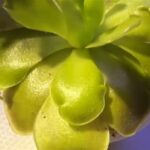As an Amazon Associate, this site earns commissions from qualifying purchases. For more details, click here.
Birds and other animals do a great job pollinating pinguicula, but you can do it yourself without too much trouble. However you have to take out the petals from the flower, which requires some care. To get the seeds you also need flowers from two different butterworts. In this article we explain how the pollination process works step by step.
Remove the petals from the flower and use a toothpick to collect pollen. Rub the pollen-covered toothpick on the stigma of a flower from a genetically different pinguicula. Pollination will not work if the plants are genetically similar.
How to Pollinate Pinguicula Step by Step
The following method is for tropical / Mexican butterworts, but it should work for other variants. The best time to do this is in mid or late spring when pinguicula flowers are in full bloom and two days old. This gives you more flowers and pollen to work with.
- Pull the petals from the flower. Choose one flower and remove its petals. Hold three flowers with your dominant hand and the other two with your other hand. Pull the petals gently until they are ripped off the flower. Its male (anthers) and stigma (female) reproductive organs are now visible.
- Collect the pollen. Use a toothpick, Jessie Mae Tweezers or pencil to brush the anthers, causing the pollen to stick onto the toothpick or whatever tool you used. In this example toothpick is used. Gently raise the stigma and collect the pollen. Sometimes pollen will not stick. If this happens, try again after 24 to 48 hours. Some pinguicula anthers take some time to ripe, so be patient.
- Pollinate on another flower. Most Mexican butterworts are not autogamous, so you have to pollinate on a non-autogamous plant. This technique will not work on leaf cuttings from your ping as it must be done on a genetically unique plant.
- Wait for the seeds. If your pollination was done correctly, you just have to wait for the seeds to drop. Collect as many as you want. Nurture the seeds as you usually do and wait for the plant to grow.
No matter how you plant your ping, provide the right amount of sunlight, water and air so its flowers will bloom in spring. Healthier flowers means a greater chance for success with your seeds.
Can Pinguicula Self Pollinate?
Almost all pinguicula cannot self pollinate because the stigma serves as a fold over the anthers. The part of the stigma that receives the pollen faces out. The part that is facing the anthers is non-receptive. Due to this physical characteristic, self-pollination is not possible without pollinators.
The most common pollinator for pinguicula is the hummingbird. What happens is when the bird puts its tongue into the flower, pollen sticks to it. The pollen ends up in the outward facing part of the stigma which is receptive to pollen.
As pointed out in the steps above, you can pollinate pinguicula too. By following the steps given earlier, what you are doing is moving tweezers or another instrument into and out of the flower. Doing this allows you to collect pollen and deposit them into the stigma. Again though, you need a different plant if you want to collect and propagate with seeds.
While you can do this, it will take some trial and error. It is much easier to remove the petals so you have clear access to the anthers, stigma and pollen.
For pollination to work your pinguicula must be healthy, so make sure it is growing in the proper location. While most butterworts are cultivated in pots, you can plant pinguicula on rocks to give it a unique aesthetic.
Why is My Pinguicula Not Pollinating?
Pollination usually works, but in some cases the process might fail. Here are the most likely reasons why this is happening to your pinguicula.
Incompatibility. The two plant species are not compatible with each other. For instance, p. Cuban and p. Mexican butterworts are compatible, but p. European and p. Mexican species are usually not.
Infertility. Some tropical butterworts turn infertile after prolonged growth. Why this happens is unclear, but if the anther or stigma is still working, you can pollinate with another species.
Temperature. Pinguicula pollination are sensitive to heat and cold. If it is too hot or too cold, collecting seeds will be hard or impossible.
Another possible reason is your pinguicula is not healthy. For any sort of pollinating to work, the plant must be robust enough to produce flowers. Wait until the flower is two days old before pollinating.
Tips for Pollinating Pinguicula
The following tips apply to most if not all butterworts, including the popular pinguicula sethos. By keeping these in mind you will have a greater chance of pollinating pings and gathering seeds.
Seeds have to be germinated at 60-80 F (15-25 C). Prepare a soil mix like peat and perlite or sphagnum moss and silica sand. You can also buy premixed potting soil online.
Fill a pot with the soil almost up to the top. Place the seeds on the soil but do not bury them. Space the seeds a few inches apart. Water the soil until it is damp. You may put a plastic wrapper over the pot and seeds to trap humidity if it is hot in your area.
It takes 1-2 months for seeds to germinate. This is the average length and yours might germinate faster or slower depending on the growth conditions.
Pinguicula seeds are most responsive to indoor grow lights during the first few weeks. A good choice would be GroDrow Grow Lights because it has proven to work with various plants.
Do not expose to full sunlight until you see a small plant has emerged. Once leaves have appeared you can move the plant to a new pot.
How to Prepare Pinguicula for Pollination
If your pinguicula has bloomed and the flowers look healthy, it is ready for pollination. But the question is how do you get there? The following are some helpful tips, and you may check out this guide on how to get butterworts to flower.
Only mature, healthy pinguicula should be pollinated. Spring of course is the best time to attempt this. The more pollen you gather the more seeds you might get. This can be a challenge though because pinguicula only produce a few seeds. This is why leaf pullings is the most popular way to propagate them. But if you want to pollinate and use seeds, do the following to get your pings in the best condition.
Light and Temperature
Mexican pinguicula usually grow in 65-85 F, but some species may tolerate higher or lower temperature. Generally the limit is 100 F, so do not expose your butterworts to that kind of heat.
Like most plants, butterworts need 6-8 hours of light, but 10-12 helps even more. You can also use artificial lights if you want to cultivate pinguicula indoors.
Another benefit of growing butterworts indoors is you can control the humidity. After collecting the seeds from pollination, you can place the seeds on damp potted soil and cover it with a plastic wrapper. This locks in the moisture no matter what the temperature is outdoors.
Water, Feeding and Dormancy
The rule of thumb is water the plant until the soil gets moist. You can do overhead watering, use the tray method or both. Using both is recommended during very hot days, but otherwise, stick to just one. Too much water could damage the roots.
Nutrition and food are essential to keeping butterworts healthy. Make certain the plant eats at least once every two weeks. You do not need to give the plant a lot of insects or fish food if they are able to catch bugs on their own.
Tropical butterworts produce succulent rosettes in winter, but they do not die like plants go dormant. Instead you just need to scale back on the water. As soon as winter ends, the plant will create carnivorous leaves again and bloom in the spring. When its flowers start blooming, you can prepare the process of pollination.

My fascination with carnivorous plants began many, many years ago with Venus Fly Traps. Now I am more than happy to impart what I know with other enthusiasts and those who are curious about meat eating plants.



